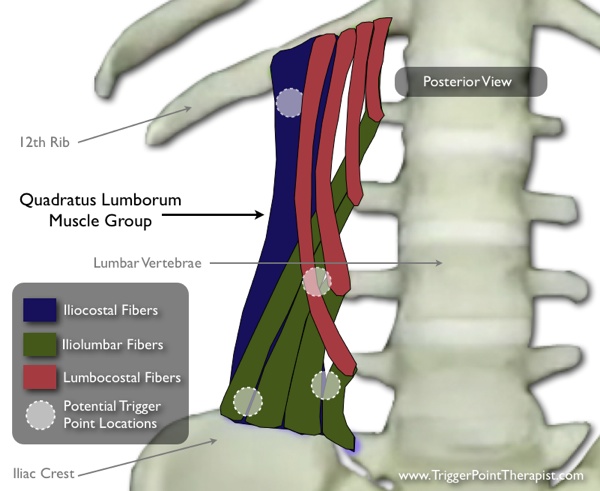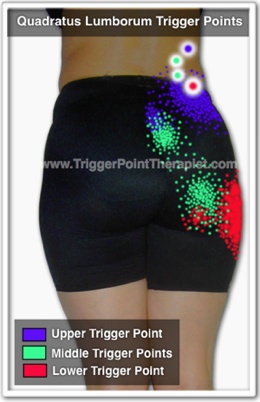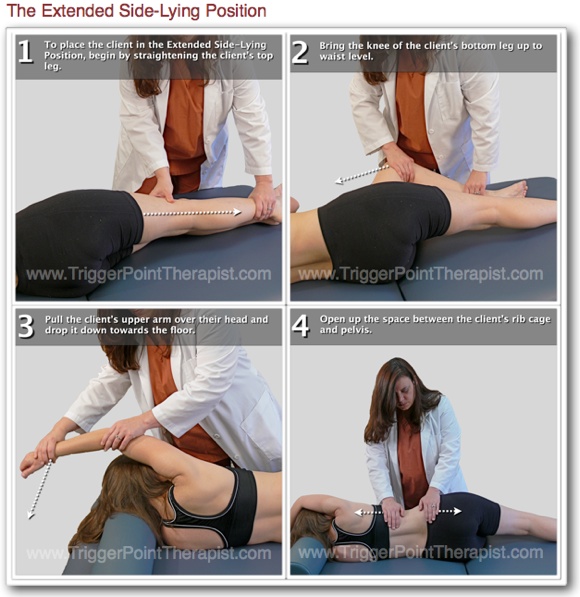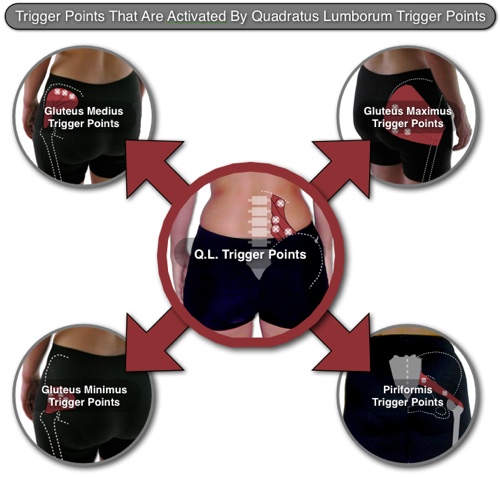The Quadratus Lumborum Trigger Points: Masters of Low Back Pain

Bow Down to the Masters of Low Back Pain
Nothing gets a person on their “hands and knees” quicker than active trigger points in the quadratus lumborum muscle. These trigger points are always on the top of my list when it comes to acute low back pain complaints, especially those cases where the pain is so severe that the client cannot stand.
The quadratus lumborum (QL) trigger points also play a prominent role in chronic low back pain cases as well, becoming a key player in the subsequent onset of sciatica symptoms and hip pain complications.
The QL trigger points are indeed the “masters of low back pain”, and if you are looking to become their master, there are some important things that you need to know.
The Quadratus Lumborum Muscle
The quadratus lumborum muscle group is not going to impress you with its size or prominence in the physique. But this small and somewhat hidden muscle group plays such a prominent role in normal body mechanics that without its functioning the upright posture of the human being is impossible to maintain.
Anatomical Highlights: To begin, I found this great video clip of from the Trail Guide to the Body DVD on youtube that I want to show you:
(In case you can’t view the video in this post, you can watch it on youtube here: http://youtu.be/VsW896n71HU)
The video above does a fantastic job at showing the position of the muscle group, but there is one more detail that I would like to highlight; this muscle group has three subsections that each have a distinct fiber direction:
- The Iliocostal fibers (shown below in blue) attach on the Iliac Crest and run vertically upward to attach to the 12th rib.
- The iliolumbar fibers (shown below in green) attach on the Iliac Crest and run diagonally upward and medially to attach to the tranverse processes of the lumbar vertebrae (L1 > L4)
- The lumbocostal fibers (shown below in red) attach on the lumbar vertebrae and run diagnonally upward and laterally to attach to the twelfth (lowest) rib.

As you can see in the diagram above, the diagonal iliolumbar and lumbocostal fibers are oriented to allow them to act as guy-wires for the lumbar spine. It is this particular anatomical feature that accounts for this muscle’s ability to stabilize the upright posture.
Biomechanical Highlights: The most important biomechanical consideration with the QL muscle relates to the guy-wire fiber arrangement discussed above. The primary antagonist to each QL muscle is the opposing QL muscle on the other side of the body. Thus, if one muscle develops trigger point activity, the muscle on the other side will become overloaded and develop trigger points as well.
From a clinical perspective, this means that the therapist should always address the trigger points in both the left and right QL muscles, even if the pain is limited only to one side.
The Quadratus Lumborum Trigger Points
As shown in the diagram above, there are four potential trigger points in the QL muscle:- The upper QL trigger point is found just lateral to where the lumbar paraspinal muscles and the twelfth rib meet. Note, this trigger point lies underneath the paraspinal muscle mass in this region, so the therapist must approach it from the side to contact it directly.
- The lower QL trigger point lies deep in the region where the paraspinal muscles meet the hip crest (iliac crest).
- The middle or deep QL trigger points lie closer to the spine than the superior or lower trigger points, next to the third and fourth lumbar vertebrae.
Quadratus Lumborum Pain

The referred pain from the QL trigger points is usually described as an intense, deep ache, but it may also have a sharp, knifelike quality at times, particularly during movement. The distribution of the referred pain is as follows:
- The upper trigger point (shown to right in blue) refers pain to the flank region of the low back, along the crest of the hip, and around the front to the upper groin region. It may also refer pain to the Sacro-Iliac (S.I.) joint, and to the scrotum and testicles on occasion.
- The lower trigger point (shown to right in red) refers pain and tenderness to the hip joint region, making laying on that side too painful during sleep.
- The middle trigger points (shown above in green) refer pain and tenderness strongly to the S.I. joint and lower buttock regions. Occasionally, these trigger points may refer a sharp, “lightening bolt” of pain to the front of the thigh.
Quadratus Lumborum Symptoms & Findings
The signs and symptoms associated with active quadratus lumborum trigger points are as follows:- Severe, deep, aching low back pain during movement or rest, and in nearly any position, but worse in the upright posture of standing or sitting.
- A sharp, knifelike pain when moving the hips/pelvis is common.
- Client’s will attempt to support and stabilize their upper body with their hands. This bracing with the hands occurs during walking and sitting, and is the hallmark sign of active QL trigger points.
- Coughing and sneezing can creating episodes of agonizing pain as the muscle contracts to stabilize the rib cage.
- Clients may be forced to crawl on their hands and knees to the bathroom when getting out of bed in the morning.
- Clients will be unable to roll to either side when laying in a face-up position.
- The pain from untreated QL trigger points may progress to involve the groin, genitalia, and sciatica symptoms.
- The low back pain from QL trigger points may also transform into severe hip pain over time that resembles trochanteric bursitis.
- A common postural distortion with QL trigger points is an elevated hip crest on the painful side.
What Causes Quadratus Lumborum Trigger Points?
The following factors may activate or reactivate trigger points in the QL muscle:- Any activity that involves bending and twisting at the waist, such as reaching for an object on the floor, can overload the QL muscle.
- Lifting heavy or awkward objects, such as a TV, especially if it involves twisting at the waist.
- Bending over to put on pants, especially if their foot becomes entangled in the pants and they lose their balance.
- Automobile accidents.
- A genetically short leg that causes a lateral tilt in pelvis, or walking or running on a sloping surface (side of the road), may predispose the QL muscles to overload and trigger point activity.
- A soft bed that sags like a hammock, or a Tempurpedic mattress, may activate or reactivate QL trigger points by placing the muscle in a shortened or stretched position for an extended period.
Treatment of Quadratus Lumborum Trigger Points
The first step in the effective treatment of the QL trigger points is being able to accurately locate and contact the trigger points. Many therapists make the mistake of trying to locate and treat these trigger points with the client in the prone (face-down) position, as you can see in the following videos:(YouTube link > http://youtu.be/v0wurbGLgpo )
(YouTube link > http://youtu.be/bTJtTuJmJaI )
(YouTube link > http://youtu.be/PwKm9KpE5Wc )
Because three of the four potential QL trigger points lie underneath the paraspinal muscles, the therapist will have difficulty contacting these trigger points with the client in the prone position.
A more effective approach to these trigger points can be achieved by placing the client on their side, with the painful side facing up. This position is called the extended side-lying position and is used specifically to address the trigger points in the QL muscle.
Placing the Client in the Extended Side-Lying Position
- The first thing that you should recognize as a therapist is that a client with active QL trigger points is going to need some help getting into and changing position on your treatment table.
- I usually start by helping the client sit on the midpoint of table with their legs hanging off one side.
- If you are going to work the trigger points in the client’s right QL muscle, for example, you should have them sit on the right side of the table, when viewed from the foot of the table.
- The client will probably place their hands on the table to each side to support their upper body weight when sitting. If they don’t do this, you should ask them to.
- Standing in front of the client, you are then going to hug their upper body, to support their upper body weight, and then slowly lay them down on the table on their left side.
- Then help them place their legs on the table and give them a pillow (or adjust the head piece) to support their neck and head.
- At this point, the client is in the standard side-lying position and the therapist needs to modify it to place the client’s right QL muscle in a slightly stretched position. To do this, following the steps in the picture below.

- When working with acute QL trigger points, the therapist should place a pillow under the client’s right knee after step 1 in the above picture. It is important not to overstretch the muscle at the beginning of the treatment, so supporting the upper knee with a pillow or bolster helps with this. After the trigger points have been released, the therapist should remove or reposition the pillow to allow for a greater stretch of the iliolumbar fibers of the QL muscles.
- To reposition the client to work the QL muscle on the other side, the therapist can simply reverse these directions to get the client back into the sitting position, being sure to hug and lift the client’s upper body as they sit up, or they can help the client roll to the other side.
- To roll the client, encircle the client’s waist with your arms and lift their lower trunk slightly off the table as they roll to their back. Then walk around to the other side of the table and repeat the waist lift to help them roll on to their right side. It is critical that the therapist help the client to roll in this manner, otherwise the QL trigger points that were just released will be reactivated by the client’s effort to roll their body.
Associated Trigger Points
The effective treatment of the QL trigger points will also require the therapist to address the associated trigger points in other muscle groups as well. In acute cases of low back pain, the therapist should include the gluteus medius trigger points in their treatment routine. In chronic cases, the gluteus medius trigger points, gluteus minimus trigger points, gluteus maximus trigger points, and piriformis trigger points will need to be addressed by the therapist.
The Quadratus Lumborum-Gluteus Medius/Minimus Connection
The referred pain from the upper QL trigger point is projected to the gluteus medius and gluteus minimus muscles, and therefore can activate the trigger points in these muscle groups (termed satellite trigger points).The relationship between the trigger points in these muscle groups is so strong, that palpation on the QL trigger points can produce the referred pain associated with the gluteus medius and minimus trigger points.
I call this fascinating phenomenon “piggy-backing” and when it occurs with the QL trigger points it often involves the sciatica symptoms (pain that travels down the leg) associated with the gluteus minimus trigger points. Release of the gluteus minimus trigger points restores the typical pain patterns of the QL trigger points.
The Quadratus Lumborum-Gluteus Maximus/Piriformis Connection
Referred pain from the middle or deep QL trigger points may also activate satellite trigger points in the gluteus maximus and piriformis muscles, though the piggy-backing phenomenon doesn’t seem to occur with these trigger points.The Quadratus Lumborum-IlioPsoas Connection
One other trigger point that can be associated with QL trigger point activity is the trigger point in the IlioPsoas muscle group. Because both of these muscle groups share a similar function, stabilizing the lumbar spine, trigger point induced weakness in one of the muscle groups tends to overload the other muscle group and cause secondary trigger points to develop within it.For more information on these trigger points, and step-by-step instructions for locating and releasing them, please consider purchasing the Trigger Point Therapy for the Quadratus Lumborum Video Download or if you have an iPad you can purchase the Trigger Point Therapy for the Quadratus Lumborum Booklet for the iPad in the iBookstore.
A link to the video excerpt is provided here: Quadratus Lumborum Pain and Trigger Points

http://www.triggerpointtherapist.com/blog/quadratus-lumborum-trigger-points/ql-trigger-points-masters-low-back-pain/
*********************************************************************************************************
Here is a very good You Tube video from sanfranciscocrossfit explaining the QL.-FC
The QL is not a bone
by: sanfranciscocrossfit
No comments:
Post a Comment